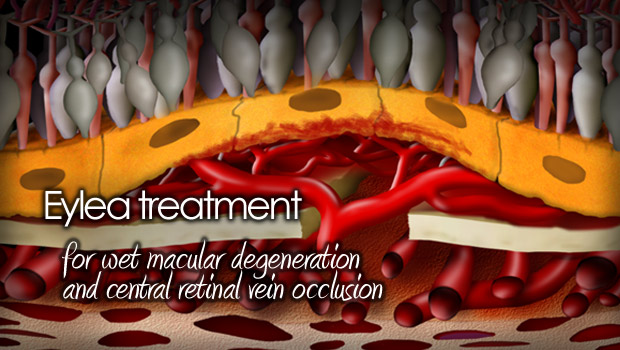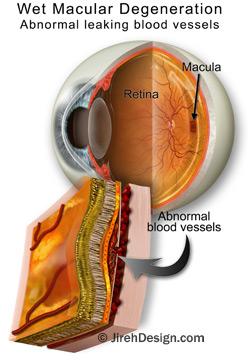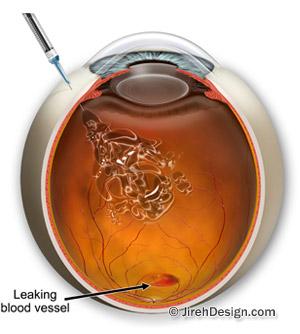Eylea macular degeneration treatment


Eylea macular degeneration treatment
Eylea is a drug that treats macular degeneration and retinal vein occlusion.
So, what does Eylea treat?
Eylea for Wet Macular Degeneration
Eylea treats more than one eye disease. The most common eye disease it treats is wet age-related macular degeneration, which is the leading cause of legal blindness in people over 50 years of age in the U.S.
There are two types of age-related macular degeneration (AMD): dry and wet. The wet form of AMD involves the development of new, abnormal vessels below the retina. The retina is a light-sensitive, multi-layered tissue that lines the back of the eyeball.
VIDEO: “The difference between wet and dry AMD”
These abnormal blood vessels leak fluid or blood into the deep layers of the retina and macula. This fluid causes symptoms ranging from a slight blur in the central vision to complete distortion or blacked-out central vision in the affected eye. Without treatment for this leaking, vision loss may be severe and permanent.
Retinal Vein Occlusion
Retinal vein occlusion (CRVO) is also treated with Eylea. Like AMD, retinal vein occlusion involves leaky abnormal blood vessels. Eylea blocks the natural chemical in our bodies, vascular endothelial growth factor (VEGF), that causes the blood vessels to leak. Once these leaking blood vessels are sealed, retinal hemorrhages and edema from the vein occlusion subside and vision is often remarkably improved.
How does Eylea work?
The technician at the doctor’s office dilates and numbs the treatment eye. After this initial numbing, Dr. Deupree injects an anesthesia medicine into the space below the conjunctiva – the clear “skin” around the whites of the eye. The doctor or technician will clean in and around the eye with a cleansing solution containing diluted Betadine to get the outside of the eyeball and eyelids as sterile as possible. About 15 minutes later, the eye is completely anesthetized and cannot feel any pain.
Once the eyeball is completely numb, Dr. Deupree injects a few drops of Eylea into the vitreous, the clear jell that fills the inside of the eyeball, using a very small needle. Of course, the patient feels no pain because of the numbing steps taken prior to the injection.
What to expect after Eylea?
Immediately following the medicine injection in your eye, the patient may notice floating “spots” or “circles” in their vision. This is due to the tiny amount of air in the syringe creating bubbles inside the eye. These air pockets are there by design and are harmless. You may notice these spots in the vision for as much as 4-5 days.
The majority of patients will not notice an immediate improvement in vision. Remember, the medicine’s job is to stop the leakage of abnormal blood vessels. However, the blood and fluid that was previously there and caused swelling in the macula is still present following treatment. Time and nature will do their part to absorb this fluid and subsequently, vision should improve and/or stabilize.
How many Eylea treatments will I need?
It is important to remember that Eylea is not a cure, only a treatment of the secondary complications that come with wet macular degeneration and central retinal vein occlusion. The Eylea drug is treating the abnormal blood vessels so they’ll stop growing and leaking, but the drug is not curing macular degeneration and vein occlusion.
Consequently, the patient may need a vast amount of Eylea injections to keep their eye condition and vision stable.
The recommended treatment doses for wet AMD is one treatment every month for 3 months, then once every 2 months after that – as long as the vision is stable. It is however not uncommon to need a treatment every 4-6 weeks instead.
Here at The Macula Center, Dr. Deupree will determine the interval of treatments that best suit your condition. He does not work off of a “template”, instead he tailors treatment to each patient and each eye based on how the eye responds and the findings of the patient’s diagnostic testing, fluorescein angiogram and OCT.
Eylea warnings
You should not receive an intraocular injection of any kind if you have an infection in or around your eye, eye pain or redness, inflammation in the eye, or a known allergy to the contents of Eylea.
Eylea side effects
The most common side effects to Eylea are: bloodshot eye, eye pain, floating spots, circles or bubbles in vision and flashes of light. Subconjunctival hemorrhage, although frightening looking, is normal and quite harmless and can take up to 10 days to clear up. As we mention earlier on this page, floating spots and circles in the vision are normal and will clear up in a few days. A decrease in vision and pain is not normal and you should contact your doctor immediately.








